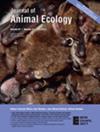环境和人为因素塑造了广泛分布的海洋捕食者的营养生态。
IF 3.7
1区 环境科学与生态学
Q1 ECOLOGY
引用次数: 0
摘要
研究营养生态驱动因素的综合方法为探索和预测全球变化不同情景下食物网动态的变化提供了知识。然而,很少有研究分析环境因素与营养相互作用之间的关系,并额外考虑其他人类压力源,如渔业。本文采用贝叶斯稳定同位素混合模型研究了西地中海和邻近大西洋海域广泛分布的中上层掠食性鱼类剑鱼(Xiphias gladius)的营养生态学。我们利用广义加性模型(GAMs)探讨了饮食估算与生物、环境和人为驱动因素之间的关系。GAMs用于对当前猎物消费量进行空间预测,并作为一项前瞻性工作,预测未来不同气候变化情景下猎物消费量的变化。总体而言,我们发现剑鱼的饮食会随着环境条件的变化而变化,特别是海面温度(SST)、混合层深度(MLD)和叶绿素-a浓度(Chl)的变化;还有捕鱼压力。鱼类消费量与海温和MLD有关。鱿鱼摄取量与海温有关,其中中等长度的剑鱼对海温贡献最大。在加那利群岛和地中海西部,鱿鱼对剑鱼的贡献更高,而在Cádiz海湾附近,胶质生物的消耗更多。在较小的剑鱼和生产力较低的地区,胶状生物的消耗量较高。我们的前瞻性研究表明,在不同的未来全球变化情景下,不同的饮食改变。我们首次提供了定量证据,证明捕捞压力和环境条件下的大尺度、时空模式如何影响剑鱼的饮食。我们的研究提供了有用的结果来评估这种捕食者的饮食,并强调如何将营养相互作用纳入预测可以提高我们对未来分布的理解。本文章由计算机程序翻译,如有差异,请以英文原文为准。




Environmental and human factors shape the trophic ecology of a widespread marine predator
求助全文
通过发布文献求助,成功后即可免费获取论文全文。
去求助
来源期刊

Journal of Animal Ecology
环境科学-动物学
CiteScore
9.10
自引率
4.20%
发文量
188
审稿时长
3 months
期刊介绍:
Journal of Animal Ecology publishes the best original research on all aspects of animal ecology, ranging from the molecular to the ecosystem level. These may be field, laboratory and theoretical studies utilising terrestrial, freshwater or marine systems.
 求助内容:
求助内容: 应助结果提醒方式:
应助结果提醒方式:


